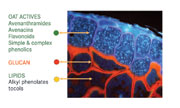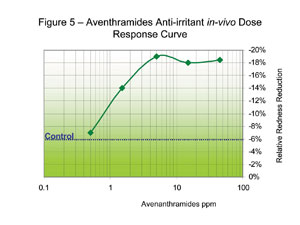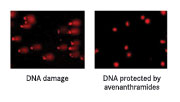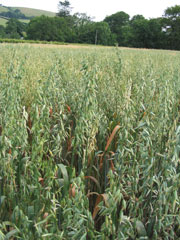There is a great demand for natural, sustainable cosmetic raw materials that also perform. Cark Maunsell and Judi Beerling explain why it’s time for oats
Sustainably sourced renewable agricultural materials, minimally processed by physical means or modified by green or ‘kitchen’ chemistry processes, are making waves as the hot new cosmetic ingredients. Organic Monitor, which tracks the market for authentic natural cosmetic products, has seen double digit global growth for the past decade and expects this trend to continue, although there was a slight dip in recession hit 2009.[1] Figure 1 shows the market value in the UK since 2005 and estimates to 2015.
The requirement for formulators to develop natural, sustainable personal care products that in turn provide real performance benefits has thus grown strongly over the past few years. They want green, natural or even organic but combined with the best skin or hair science has to offer. This has led some formulators to re-evaluate long known ingredients with proven functionality and new application research has been able to demonstrate enhanced benefits.
The use of food derived ingredients in personal care also provides a perception of healthiness and nutritional value for the skin.[2] Oats have traditionally been viewed as healthy to eat, however their popularity has exploded in recent years with not only the addition of innovative products but also increasing awareness of their cholesterol lowering properties. They are also increasingly recognised as an ingredient with very low allergenic potential, but very high, proven, therapeutic value.
Oats (Avena sativa) are a cereal that has been used since Roman times to soothe and heal the skin, whilst reducing inflammation and redness. Natural oat extracts offer a new source of oat-based cosmetic raw materials with a guaranteed content of the potent active ingredients, including as avenanthramides, proteins or beta glucans.
Avenanthramides are known to suppress histamine release at very low levels, whilst oat beta glucans improve pro-collagen synthesis, helping to plump up the skin, reduce wrinkles and restore the skin’s natural moisture barrier. Other oat components, such as oat oil and hydrolysed oat proteins, also offer unique cosmeceutical benefits thereby making the humble oat multifunctional in use.
Oat Cosmetics, a new UK-based supplier of cosmetic ingredients, has worked with partners (eg Ceapro in Alberta, Canada) to offer a range of unique, renewable, natural oat-based actives produced using state-of-the art, proprietary, ‘green’ extraction technology.
We all know that eating your daily porridge or muesli offers health benefits, but what do oats have to offer the cosmetics formulator? Figure 2 shows the location of the major active phytochemicals in the oat kernel.

Figure 2: Location of the major active phytochemicals in the oat kernel
Oat beta glucan
Figure 3 shows the structure of oat beta glucan. It is an unbranched, linear glucose polymer with β(1-4) and β(1-3) glucosidic linkages in a ratio of 4:1.
Other natural sources, such as yeast and fungi, can yield beta glucans, but these have a different branched structure and are insoluble in water and are usually of lower molecular weight.
Oat beta glucan is a known cytokine inducer, particularly of interleukin-1 (IL-1). Cytokines are proteins produced by the immune system, lymphocytes and other cells that regulate cellular processes such as proliferation and differentiation. In the skin oat beta glucan helps with infection control and collagen stimulation. It stimulates fibroblasts and production of pro-collagen as well as the healing process. Treatment of burns is one area where oat beta glucans have been safely used for many years.
Hydration of the skin is improved by oat beta glucan and in the pharmaceutical field dermal penetration and enhanced drug delivery are important characteristics. Whilst most isolated glucans are aggregates of a micron size or greater, Ceapro oat beta glucan is sub-micron sized, allowing it to penetrate well into the epidermis and even the dermis.

Figure 3: Structure of oat beta glucan
In the anti-ageing field, anti-wrinkle effects from topical application of oat beta glucan have been demonstrated. One study investigated skin penetration and anti-ageing effects of oat beta glucan.[3] A half-face design, anti-wrinkle study used 27 subjects with 0.1% topical beta-glucan, or a placebo, applied twice a day for eight weeks. By the end of the study the digital analysis of silicone replicas of the beta-glucan treated areas showed significantly reduced roughness and wrinkling (of up to 15%) versus the placebo. Skin firmness was also increased.
For hair care, oat beta glucan strengthens the hair, increases combability, improves elasticity and works to protect against brittleness and damage.
Oat Avenanthramides
Oats (as oatmeal) have been used to treat irritated skin for centuries. Avenanthramides in oats have been shown to be the main group of active polyphenol antioxidants responsible for their anti-inflammatory, anti-erythema (anti-redness), anti-pruritic (anti-itch) and anti-histamine properties.[4] Figure 4 shows their chemical structure.
Figure 4: Chemical structure of oat avenanthramides
Many mothers know the benefits of the addition of a handful of oatmeal to the baths of children suffering from eczema and other inflammatory skin conditions. Ceapro scientists were the first to identify the link between the traditional symptomatic relief from oatmeal and the clinical activity of avenanthramides.[5] Studies in the past few years have suggested that oat avenanthramides may be beneficial in the treatment of inflammatory bowel disease and colon cancer.[6]An amazing property of these antioxidants is the very low level at which they are active. In fact sometimes less really is more; the anti-irritant activity, measured as redness reduction, peaks at around 5ppm (figure 5). Since the material is sold at a standardised concentration of 100ppm, this equates to around a 5% use level, making these materials highly cost effective, though good activity has actually been seen at as low as 0.5%.

Figure 5: Redness reduction activity of oat avenanthramides
Another highly pertinent benefit of oat avenanthramides is their ability to protect the DNA of skin cells against external environmental aggression. An electrophoresis technique was used to detect cellular DNA damage caused by UV irradiation. Figure 6 shows the results of this test. The small comet-like tails indicate DNA damage, which is significantly reduced by the addition of oat avenanthramides.[7] Thus these materials make an excellent addition to sunscreens and post-sun treatment products.

Figure 6: Reduction in DNA damage
Anti-itching is another interesting area of research. In a mast cell model, colloidal oat extract was shown to inhibit substance P induced histamine release from mast cells. A 75% reduction of histamine release was achieved with 5ppm avenanthramides. Figure 7 illustrates the statistically significant (P<0.05) rapid relief from allergy symptoms following avenanthramide treatment.[8] After 30 minutes itching was reduced by 50%, after one hour redness was reduced by more than 85% and after two hours the wheal area (redness circle) was reduced by 90%. Although products making anti-itch claims would be classified as drugs in most countries, the inclusion of avenanthramides in cosmetic products for sensitive or easily irritated skin would appear to be highly beneficial.

Figure 7: Relief from allergy symptoms
In hair care, oat avenanthramides have been shown to prevent hair lipid peroxidation and relieve scalp itching and sensitivity, suggesting this material as an ideal active ingredient for scalp care formulations.
Oat peptides
Another interesting extract from the oat kernel are the peptides. Available as a clear aqueous solution with a light straw colour and a very low odour, the product is a useful alternative for hydrolysed proteins, such as wheat, that are often more highly coloured and odourous. Concerns over possible allergic reactions to wheat or gluten, whether scientifically proven or not, also make these oat peptides attractive alternatives for natural cosmetics.

Oat Cosmetics’ oat peptides are chemically unmodified, are soluble over a wide pH range and have outstanding emulsifying properties and water binding capacity. The product proves negative when tested for a typical gluten response and exhibits excellent foaming properties, making them a useful addition to shampoos, shower gels and other surfactant-based products. The benefit of using these peptides in skin or hair products hinges on their ability to form a protective film which imparts protection and moisturisation. Furthermore, the peptides have the ability to penetrate the cortex with only a single application. In hair care, claims such as repairing damaged hair, conditioning and protecting the hair and improving shine and silky feel could be supported by the inclusion of this material.
Formulating with oats
For those who want traditional products but with a modern specification, the production of certified natural colloidal oatmeal is also being investigated with a view to producing a cost effective, high performance, non-irradiated product. There is little of the oat which does not have a cosmetic use as the hull has been subject to an innovative process to produce effective face and body exfoliants.
All of the above stated benefits make the inclusion of oat-based ingredients an interesting option for formulators of high performance cosmetic products. As these materials are Ecocert approved (or have in progress) for use in natural products, this also makes them an obvious choice for natural skin and hair care products. The range of possible products that could utilise these multifunctional active ingredients is only limited by imagination. So natural, healthy, green and high performance is now a real possibility, and all from something that has been under our noses for centuries. The humble oat really has come of age.
Authors
Cark Maunsell, Oat Cosmetics
Judi Beerling, Organic Monitor
Contact
Cark Maunsell, managing director, Oat Cosmetics, UK
tel +44 23 8076 7228
www.oak.co.uk
References
1. Organic Monitor Ltd, Market Report, The UK Market for Natural Personal Care Products (2009)
2. Organic Monitor Ltd, Technical Insights Report, Formulating Cosmetics Using Natural Food Ingredients (2010)
3. Pillai R, Redmond M & Röding J, Anti-Wrinkle Therapy: Significant New Findings in the Non-Invasive Cosmetic Treatment of Skin Wrinkles with Beta-Glucan, IFSCC Magazine, 1 (2005)
4. Sur R, Nigam A, Grote D, Liebel F & Southall MD, Avenanthramides, polyphenols from oats that exhibit anti-inflammation and anti-itch activity, Arch Dermatol Res, 300:569-574 (2008)
5. Vollhardt J, Fielder DA & Redmond MJ, Identification and cosmetic application of powerful anti-irritant constituents of oat grain, XXI IFSCC International Congress, Berlin, proceedings, 395-402 (2000)
6. Lin Ne L, Wise M, Collins W & Meydani M, Avenanthramides inhibited cell proliferation and COX2 expression in human colon cancer cells, Experimental Biology/The FASEB Journal, 21(5), pA102 (2008)
7. ABIPO: Antioxidant Based Industrial Products from Oats, Competitive Industrial Materials from Non Food Crops, UK (2005)
8. Schmaus G, Hermann M, Joppe H, Lange S, Pillai R & Roding J, Oat avenanthramides - new actives to reduce itch sensation in skin, Proceedings of the 23rd IFSCC International Congress, Poster I95, Orlando, October 24-27 (2004)
Note – Some of the major issues concerning natural cosmetics will be featured extensively at the Sustainable Cosmetics Summit in Paris (18-20 October 2010).




